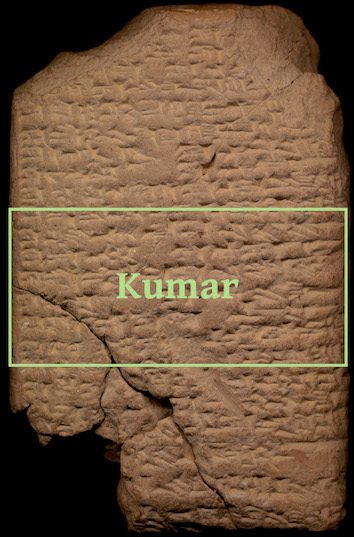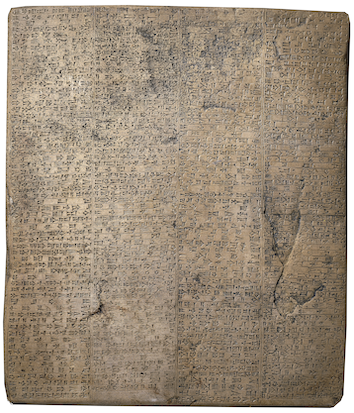Edikukalama (temple of Šamaš at Babylon)
Edikukalama was one of the seven religious buildings in the Kumar district of West Babylon, at least according to Tablet IV of the scholarly compendium Tintir = Babylon. That temple was dedicated to the sun-god Šamaš. This temple, which is first mentioned in cuneiform sources from the Old Babylonian Period (ca. 1900–1600 BC), was the third most important temple of the sun-god in Babylonia, after that god's temples in Sippar (Ebabbar) and Larsa (also called Ebabbar). The industrious Neo-Babylonian king Nebuchadnezzar II (r. 604–562 BC), the man who had Babylon transformed into an imperial megacity, claims to have rebuilt Edikukalama, together with three other temples in West Babylon.

Names and Spellings
This temple at Babylon went by the Sumerian ceremonial name Edikukalama, which means "House of the Judge of the Land."
- Written Forms: e₂-di-ku₅-kalam-ma.
Known Builders
- Old Babylonian (ca. 1900–1600 BC)
- Apil-Sîn (r. 1830–1813 BC)
- Damiq-ilīšu (r. 1816–1794 BC)
- Neo-Babylonian (ca. 625–539 BC)
- Nebuchadnezzar II (r. 604–562 BC)
Building History
According to two Old Babylonian year names, Edikukalama received attention not only from local kings of Babylon, but also from rulers of Isin, men who held authority over Babylon before that city asserted its political dominance. In his sixteenth year (ca. 1814 BC), Apil-Sîn (the fourth ruler of the First Dynasty of Babylon) constructed a magnificent gold(-plated) throne dais for the sun-god. A few years later, in ca. 1808 BC, Damiq-ilīšu, the fifteenth and last ruler of the First Dynasty of Isin, claims to have rebuilt Edikukalama.

BM 129397, a large stone tablet that bears a long Akkadian inscription that is now commonly referred to as the "East India House Inscription." The description of Nebuchadnezzar's rebuilding of Edikukalama is recorded in lines iv 29–34. Image adapted from the British Museum Collection website. Credit: Trustees of the British Museum.
After the reign of Damiq-ilīšu of Isin until the time of Nebuchadnezzar II, the son and immediate successor of the founder of the Neo-Babylonian Empire (Nabopolassar [r. 625–605 BC]), virtually nothing is known about the history of Edikukalama. Reference in the now-famous "Sun-God Tablet" to the discovery of a representation of Šamaš' cult statue and regalia on the western bank of the arm of the Euphrates River that ran through Babylon (the Arahtu) seems to infer that Edikukalama had fallen into such a bad state of disrepair that its brick structure was no longer recognizable while Nabû-apla-iddina was king. Whether that Akkadian text's depiction of this temple of Šamaš in the early first millennium BC reflects historical reality or is simply a literary motif is open to debate.
Several Akkadian inscriptions of Nebuchadnezzar II, including one written on a large stone tablet (the so-called "East India House Inscription") and a few written on rock faces in Lebanon, record that this ruler rebuilt Edikukalama's structure with bitumen (Akkadian kupru) and baked brick (Akkadian agurru); this was one of four religious structures that he claims to have renovated in West Babylon.
Archaeological Remains
Edikukalama has not yet been positively identified in the archaeological record.
Further Reading
- George, A.R. 1992. Babylonian Togographical Texts (Orientalia Lovaniensia Analecta 40), Leuven, pp. 327–329.
- George, A.R. 1993. House Most High. The Temples of Ancient Mesopotamia (Mesopotamian Civilizations 5), Winona Lake, pp. 74–75 no. 151.
- Pedersén, O. 2021. Babylon: The Great City, Münster, p. 199.
Jamie Novotny & Joshua Meynell
Jamie Novotny & Joshua Meynell, 'Edikukalama (temple of Šamaš at Babylon)', Babylonian Temples and Monumental Architecture online (BTMAo), The BTMAo Project, a sub-project of MOCCI, [http://oracc.org/btmao/Babylon/TemplesandZiggurat/Edikukalama/]